Cite this document
(“Quantitative analysis Article Example | Topics and Well Written Essays - 1250 words”, n.d.)
Quantitative analysis Article Example | Topics and Well Written Essays - 1250 words. Retrieved from https://studentshare.org/nursing/1653041-quantitative-analysis
Quantitative analysis Article Example | Topics and Well Written Essays - 1250 words. Retrieved from https://studentshare.org/nursing/1653041-quantitative-analysis
(Quantitative Analysis Article Example | Topics and Well Written Essays - 1250 Words)
Quantitative Analysis Article Example | Topics and Well Written Essays - 1250 Words. https://studentshare.org/nursing/1653041-quantitative-analysis.
Quantitative Analysis Article Example | Topics and Well Written Essays - 1250 Words. https://studentshare.org/nursing/1653041-quantitative-analysis.
“Quantitative Analysis Article Example | Topics and Well Written Essays - 1250 Words”, n.d. https://studentshare.org/nursing/1653041-quantitative-analysis.


